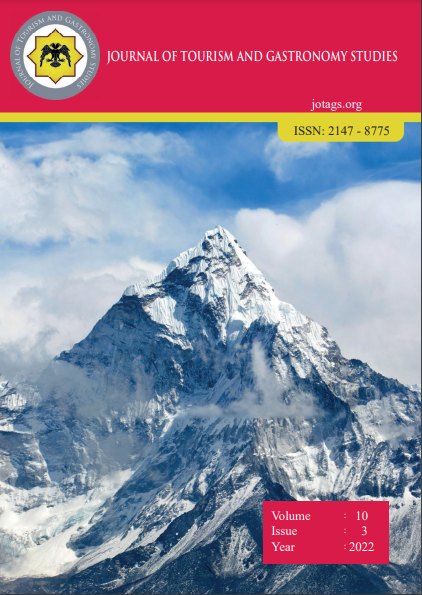Asya-Pasifik Ülkelerinde Turizm, Enerji, Büyüme ve Çevre İlişkisinin İkinci Nesil Panel Nedensellik Testi ile İncelenmesi (Investigation of the Relationship between Tourism, Energy, Growth and Environment in Asia-Pacific Countries by Second Generation Panel Causality Test)
DOI:
https://doi.org/10.21325/jotags.2022.1072Keywords:
Tourism revenues, Carbon emissions, Energy consumption, Economic growth, Causality testAbstract
This study aims to determine the direction of the causal relationship between tourism, energy, growth and environment in the countries that attract the most tourists (Japan, China, New Zealand, Singapore and Thailand) in the Asia-Pacific region, which is one of the areas where tourism movements are intense. In the study covering the period between 1995 and 2020, the panel granger causality test proposed by Emirmahmutoglu and Köse (2011) is used to determine the relationship between the variables. According to the empirical findings obtained for the overall panel; A unidirectional causality has been found from carbon emissions (CO2) to tourism revenues (TG). A bidirectional causality relationship was found between energy consumption (ET) and carbon emission (CO2) variables for both models for the entire panel. No causal relationship was found in other models. It was observed that the results differed according to the individual horizontal section.
References
Arı, A. (2021). Yenilenebilir enerji, turizm, CO2 ve GSYİH ilişkisinin Türkiye için analizi. Akademik Yaklaşımlar Dergisi, 12(2), 192-205.
Balli, E., Sigeze, C., Manga, M., Birdir, S. & Birdir, K. (2019). The relationship between tourism, CO2 emissions and economic growth: a case of Mediterranean countries. Asia Pacific Journal of Tourism Research, 24(3), 219-232.
Baltagi, B. H. (2008). Econometric Analysis of Panel Data. John Wiley & Sons.
Jebli, B. M. & Hadhri, W. (2018). The dynamic causal links between CO2 emissions from transport, real GDP, energy use and international tourism. International Journal of Sustainable Development & World Ecology, 25(6), 568-577.
BP. 2021. Statistical review of world energy. https://www.bp.com/en/global/corporate/energy-economics/statistical-review-of-world-energy. html
Bramwell, B. & Lane, B. (1993). Sustainable tourism: an evolving global approach. Journal of Sustainable Tourism, 1(1).
Breusch, T. S. & Pagan, A. R. (1980). The Lagrange multiplier test and its applications to model specification in econometrics. The Review of Economic Studies, 47(1), 239-253.
Dogan, E. & Aslan, A. (2017). Exploring the relationship among CO2 emissions, real GDP, energy consumption and tourism in the EU and candidate countries: Evidence from panel models robust to heterogeneity and cross-sectional dependence. Renewable and Sustainable Energy Reviews, (77), 239-245.
Emirmahmutoğlu, F. & Köse, N. (2011). Testing for granger causality ın heterogeneous mixed panels. Economic Modelling, (28), 870-876.
Gerçeker, M., Özcan, C. C., Mucuk, M. & Özmen, İ. (2019). Küreselleşme, reel gelir ve turizmin çevre üzerindeki etkisi: akdeniz ülkeleri örneği. In International Congress of Energy, Economy and Security, 08-10.
Jumbe, C. B. L. (2004). Cointegration and causality between electricity consumption and gdp: empirical evidence from malawi. Energy Economics, 26(1), 61-68.
Karadağ, H. (2021). Türkiye Ekonomisinde 1990-2016 Döneminde turizm ve çevre ilişkisinin ekonometrik analizi. Türk Turizm Araştırmaları Dergisi, 5(1), 164-175.
Katırcıoğlu, S.T., Feridun, M. & Kılınc, C. (2014). Estimating tourism-induced energy consumption and CO2 emissions: the case of Cyprus. Renewable and Sustainable Energy Reviews. 29, 634–40.
Lee, J. W. & Brahmasrene, T. (2013). Investigating the influence of tourism on economic growth and carbon emissions: Evidence from panel analysis of the European Union. Tourism Management, (38), 69-76.
Nosheen, M., Iqbal, J. & Khan, H. U. (2021). Analyzing the linkage among CO2 emissions, economic growth, tourism, and energy consumption in the Asian economies. Environmental Science and Pollution Research, 28(13), 16707-16719.
Özcan, C. C., Bekun, F. V. & Nazlioglu, S. (2021). Tourism‐induced pollutant emissions in Mediterranean countries: Evidence from panel causality analysis. International Social Science Journal, (71), 261-281.
Özcan, C. C., Gerçeker, M. & Özmen, İ. (2016). Turizm ve çevre ilişkisinin ekonometrik bir analizi. Uluslararası Politik, Ekonomik ve Sosyal Araştırmalar Kongresi, İstanbul.
Paramati, S. R., Alam, M. S. & Chen, C. F. (2017). The effects of tourism on economic growth and CO2 emissions: a comparison between developed and developing economies. Journal of Travel Research, 56(6), 712-724.
Pesaran, M. H., (2004), Estimation and inference in large heterogeneous panels with a multifactor error structure, CESifo Working Paper, No. 1331, Center for Economic Studies and İfo Institute (CESifo), Munich.
Pesaran, M. H. (2007). A simple panel unit root test in the presence of cross‐section dependence. Journal of Applied Econometrics, 22(2), 265-312.
Peseran, M.H., Ullah, A. & Yamagata, T. (2008). A bias-adjusted lm test of error cross-section ındependence. Econometrics Journal, 11, 105– 127.
Salihoğlu, E. (2019). Sürdürülebilir bir gelecek için yeşil bankacılıkta kilometre taşları: Türkiye uygulaması. 4.Uluslararası Sosyoloji ve Ekonomi Kongresi, Ankara.
Satrovic, E. & Muslija, A. (2019). The empirical evidence on tourism-urbanization-Co2 emissions nexus. Advances in Hospitality And Tourism Research, 7 (1), 85-105.
Swamy, P. A. V. B. (1970), Efficient inference in a random coefficient regression model. Econometrica, 38 (2). 311-323.
Tatoğlu, F. Y. (2018). Panel Zaman Serileri Analizi Stata Uygulamalı, Beta Yayınları, İstanbul.
Tiwari, A. K., Ozturk, I. & Aruna, M. (2013). Tourism, energy consumption and climate change in OECD countries. International Journal of Energy Economics and Policy, 3(3), 247-261.
Tovar, C. (2008). Lock wood m. social impacts of tourism: an australian regional case study. İnternational Journal of Tourism Research, (10), 365–78.
UNWTO & WMO. (2008). Climate Change and Tourism: Responding to Global Challenges.
United Nations Environmental Programme (UNEP), United Nations World Tourism Organization (UNWTO). (2005). Making Tourism More Sustainable: A Guide for Policy Makers. UNEP: Paris.
WTTC. (2022). Travel & Tourism Economic Impact Research Methodology. Oxford Economics (April 2022). Erişim Linki:https://wttc.org/Portals/0/Documents/Reports/2022/WTTC%20methodology%20report%202022.pdf?ver=2022-06-13-202957-567
World Development Indicator (WDI). E.T. 13.04.2022
World Travel and Tourism Council (WTTC). (2016). Travel and tourism: economic impact 202 United World. World Travel & Tourism Council, London.
Yıldırım, B. I. & Şahin, D. (2018). Geçiş ekonomilerinde turizme ve enerjiye dayalı büyüme hipotezinin analizi: panel nedensellik testi. Iğdır Üniversitesi Sosyal Bilimler Dergisi. (16), 437-457.
Zaman K., Khan M. M. & Ahmad M. (2011). Exploring the relationship between tourism development indicators and carbon emissions: a case study of Pakistan. World Applied Sciences Journal (15), 690–701.
Zhang, L. & Gao, J. (2016). Exploring the effects of international tourism on China's economic growth, energy consumption and environmental pollution: Evidence from a regional panel analysis. Renewable and Sustainable Energy Reviews, (53), 225-234.
Downloads
Published
How to Cite
Issue
Section
License
Copyright (c) 2023 Journal of Tourism & Gastronomy Studies

This work is licensed under a Creative Commons Attribution-NonCommercial 4.0 International License.








